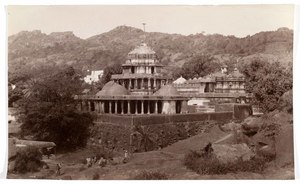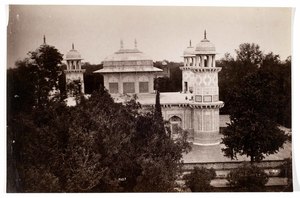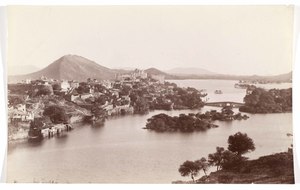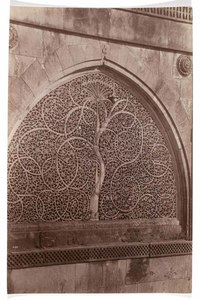Enumeration of achievements of pioneering Indian photographer Lala Deen Dayal (a leading court photographer in the Princely states of India in the late nineteenth century, whose patrons included the Maharaja of Indore and the sixth Nizam of Hyderabad; official photographer to the Viceroy beginning in 1888; appointed "Photographer to Her Imperial Majesty Queen Victory" by royal warrant in 1897; award a medal for excellence at the 1893 World's Columbian Exposition in Chicago; proprietor of successful photography studios in Bombay, Secunderadab, and Indore...) speaks to Dayal's ability to traverse boundaries between discrete spheres of Indian society and to distinguish himself within Indian as well as British colonial communities.
Dayal’s work spans diverse photographic categories according to the needs of his employers, including society and commercial portraiture, documentation of significant events (from the visits of British dignitaries to catastrophic droughts and floods within the Nizam’s region), and topographical and architectural photography. Dayal’s photographs of the great temples and monuments of India, which describe intricate architectural detail and frequently include of a tiny human (or cow) for scale, form a record of India's cultural patrimony comparable in aesthetic and motivation to the well-known images of French cathedrals and chateaux compiled by the “Missions Héliographiques” under the Commission des Monuments Historiques beginning in 1851.
Photography arrived in India from Britain in the 1840s, and the first photographic schools and societies, established in Bombay, Bengal, and Madras in the mid-1850s, were comprised exclusively of British colonials; among the only Indians practicing photography at this time were the extremely wealthy, like the Maharajas of Jaipur and Benares. An unlikely photographer, born in Sardhana in 1844 to a family of Jain jewelers of the “lower subordinate class,” Lala Deen Dayal trained as a draftsman at Thomas Engineering College and began his career at Indore’s Public Works Department around 1866. Likely learning the rudiments of photography through his training as an engineer, Dayal pursued photography professionally beginning in the early 1870s; encouraged by the Maharaja of Indore, Dayal opened a studio in 1875. Shortly thereafter, Dayal photographed the Prince of Wales (later King George V) on a tour of India, amplifying the prestige of his studio. In 1882, he assisted Sir Lepel Griffin on an architectural tour of India, producing images for the 1886 publication, Griffin’s Famous Monuments of Central India.
Employed by the sixth Nizam of Hyderabad (an Islamic dynasty in India) in 1894, Dayal captured opulent palace interiors and pageantry, the recreation and leisure activities of the Nizam, as well as intimate portraits of the royal family. The eloquent Nizam famously dubbed Dayal: Raja Bahadur Mussavir Jung, or “Bold Warrior of Photography.”
In 1896, Dayal opened his largest photographic studio in Bombay. Interestingly, strict social codes concerning the viewing of women outside the home led to the establishment of separate studio facilities, referred to as zenana, solely for photography by and of women. A British woman named Mrs. Kenny-Lavick, trained by Dayal, is known to have operated the zenana branch of Dayal & Sons in Hyderabad.
Following Dayal’s death in 1905, Dayal’s one living son took over his studio enterprise. The fact that Dayal wrote an autobiography in 1899, A Short Account of My Photographic Career, indicates the success and celebrity he experienced during his lifetime, and anticipates Dayal's enduring reputation in India, as “the first Indian photographer to earn international renown for his pioneering work in the field of photography in the subcontinent.”
Anna Linehan















